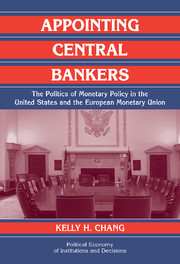 Appointing Central Bankers
Appointing Central Bankers Book contents
- Frontmatter
- Contents
- List of Figures
- List of Tables
- Acknowledgments
- 1 Introduction
- 2 A Formal Model of the Appointment Process
- 3 Estimating Monetary Policy Preferences
- 4 Empirically Testing the Model's Predictions
- 5 Appointments to the European Central Bank
- 6 The Origins of the Federal Reserve Appointment Process
- 7 Conclusions
- Bibliography
- Index
- Titles in the series
2 - A Formal Model of the Appointment Process
Published online by Cambridge University Press: 05 September 2009
- Frontmatter
- Contents
- List of Figures
- List of Tables
- Acknowledgments
- 1 Introduction
- 2 A Formal Model of the Appointment Process
- 3 Estimating Monetary Policy Preferences
- 4 Empirically Testing the Model's Predictions
- 5 Appointments to the European Central Bank
- 6 The Origins of the Federal Reserve Appointment Process
- 7 Conclusions
- Bibliography
- Index
- Titles in the series
Summary
This chapter presents a formal model of the process by which the president and Senate appoint members to the Fed. The model lays out the president and Senate's strategic considerations when they are faced with an appointment opportunity posed by either the retirement or by the expiring term of a Fed member. The president moves first with his power of nomination and thinks about how to exploit that first-mover advantage, while the Senate tries to maximize its veto power over the president's choice of nominee. Once they agree on a nominee, the president and Senate face constraints on how far they can move Fed policy with a single appointment; the Fed's multimember decision-making structure forces the president and Senate to work around the existing Fed members. In sum, the model details how preferences work within the constraints of the appointment process to produce monetary policy.
The model encompasses several of the theories of appointments discussed in Chapter 1. The first is presidential anticipation: in the model presented here, the president always anticipates the Senate's preferences. Under a certain set of circumstances, this means that the president dominates, and at other times, the president compromises with the Senate. Under still other circumstances, neither dominates, and both in a situation of deadlock simply maintain the current policy. Thus given presidential anticipation, the model demonstrates that presidential dominance, presidential compromise, or deadlock can occur.
- Type
- Chapter
- Information
- Appointing Central BankersThe Politics of Monetary Policy in the United States and the European Monetary Union, pp. 20 - 36Publisher: Cambridge University PressPrint publication year: 2003
